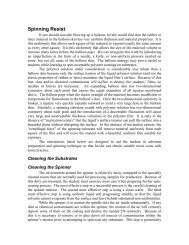A Practical Guide to SPM
A Practical Guide to SPM
A Practical Guide to SPM
You also want an ePaper? Increase the reach of your titles
YUMPU automatically turns print PDFs into web optimized ePapers that Google loves.
4<br />
I. Introduction<br />
In the early 1980s, scanning probe microscopes (<strong>SPM</strong>s) dazzled the<br />
world with the first real-space a<strong>to</strong>mic-scale images of surfaces. Now,<br />
<strong>SPM</strong>s are used in a wide variety of disciplines, including fundamental<br />
surface science, routine surface roughness analysis, and spectacular<br />
three-dimensional imaging — from a<strong>to</strong>ms of silicon <strong>to</strong> micron-sized<br />
protrusions on the surface of a living cell.<br />
The scanning probe microscope is an imaging <strong>to</strong>ol with a vast<br />
dynamic range, spanning the realms of optical and electron<br />
microscopes. It is also a profiler with unprecedented resolution. In<br />
some cases, scanning probe microscopes can measure physical<br />
properties such as surface conductivity, static charge distribution,<br />
localized friction, magnetic fields, and elastic moduli. Hence, <strong>SPM</strong><br />
applications are very diverse.<br />
This guide was written <strong>to</strong> help you learn about <strong>SPM</strong>s, a process that<br />
should begin with a thorough understanding of the basics. Issues<br />
covered in this guide range from fundamental physics of <strong>SPM</strong>s <strong>to</strong><br />
practical capabilities and instrumentation. Examples of applications<br />
are included throughout.<br />
The origins of Veeco <strong>SPM</strong>s go back <strong>to</strong> the late 1980s. Since that time,<br />
we have maintained strong ties <strong>to</strong> the academic community and a<br />
corporate philosophy that combines technology leadership with a<br />
practical-applications orientation, working with cus<strong>to</strong>mers <strong>to</strong><br />
demonstrate the ability of our <strong>SPM</strong>s <strong>to</strong> meet their needs. We believe<br />
that the more you know about scanning probe microscopes, the more<br />
likely you will be <strong>to</strong> choose the best instrument for your work. We want<br />
<strong>to</strong> provide you with the basic facts about <strong>SPM</strong>s before you make your<br />
way through sales literature.<br />
II. How an <strong>SPM</strong> Works<br />
Scanning probe microscopes are a family of instruments used for<br />
studying surface properties of materials from the micron all the way<br />
down <strong>to</strong> the a<strong>to</strong>mic level. Two fundamental components that make<br />
scanning probe microscopy possible are the probe and the scanner.<br />
The probe is the point of interface between the <strong>SPM</strong> and the sample;<br />
it is the probe that intimately interrogates various qualities of the<br />
surface. The scanner controls the precise position of the probe in<br />
relation <strong>to</strong> the surface, both vertically and laterally.<br />
The Probe<br />
When two materials are brought very close <strong>to</strong>gether, various<br />
interactions are present at the a<strong>to</strong>mic level. These interactions are the<br />
basis for scanning probe microscopy. An <strong>SPM</strong> probe is a component<br />
that is particularly sensitive <strong>to</strong> such interactions and is designed <strong>to</strong><br />
sense them. Specifically, when an <strong>SPM</strong> probe is brought very close <strong>to</strong>
















